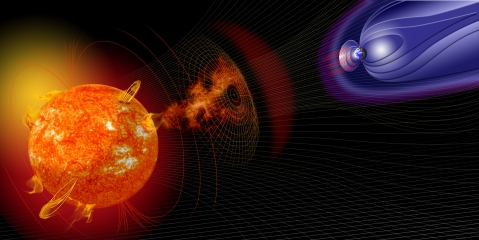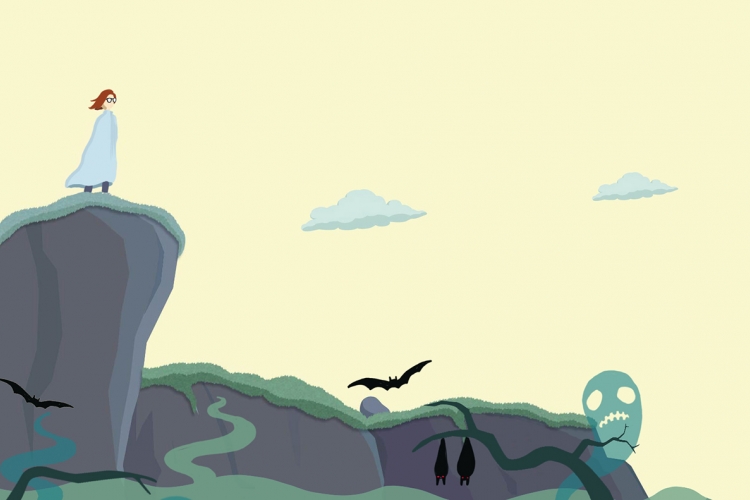In 2016, Dr. Alexa Halford and the Community Coordinated Modeling Center (CCMC) at the NASA Goddard Space Weather Research Center spearheaded the creation of a methodology for collaborating on projects between researchers and users. Halford is a member of Aerospace’s Space Sciences Department where she researches the dynamics of the Earth-space radiation environment and development of space weather tools. As a partnership between NASA, NSF, the Air Force, NOAA, and the Office of Naval Research, the CCMC is a multi-agency that provides access to modern space science simulations for the international research community.
Space Weather Communication Needs
The CCMC recognized that the space weather community, which includes researchers and end users (which can be anybody in government or industry), operated in silos. The community also encompasses many subfields, including space weather operators, and solar, magnetospheric, and ionospheric physics.
To add to the disconnect, different specialties within the space weather community also often used different jargon although they refer to the same thing. These factors made effectively communicating valuable, useful information about research or industry needs difficult. It was clear that a standardized method of communication and process was needed for researchers to discover the requirements and needs of the user community. It was also noted that there was a need for a means where users can find research to produce useful tools to aid in their decision-making processes. Ultimately, improved communication would help to build a bridge across the “valley of death,” a term used to describe the disconnect between researchers and product developers.
AUL Framework Unites Researchers and Users
Along with research partner, Dr. Adam Kellerman, an assistant researcher in Earth, Planetary and Space Sciences at UCLA, Halford is leading a worldwide effort of 24 authors from 19 institutions in six different countries to create the Application Usability Level framework (AUL). The AUL framework is a methodology for translating pure research into a product or solution for a scientific or practical real-world problem, also known as an application. Its intent is to aid in communication between researcher and user, track progress of a project towards completion, and advertise user needs and research capabilities.
The AUL framework identifies and includes many best practices for how research collaborators and users can work together. The AUL framework indicates where clear communication is necessary to define the requirements and metrics of the application, and encourages continued communication between researchers and users. Within the framework there are multiple levels which assess the feasibility and viability of the project.
The AUL framework was developed to provide flexibility for the researcher and user to adapt their needs for a specific application. This flexibility allows the AUL framework to become a standard tool for most scientific collaborations and projects, allowing for consistency across projects.
AUL Framework Animation
Phases of the Application Usability Level Framework
The AUL framework is set up in three phases and each phase has three milestones:
In Phase I: Discovery and Viability; researchers and users discover that the user has a need and the researcher may have a possible product or application to fill that need. After establishing a partnership, the researcher tests and verifies that they truly have a product that the user needs. Both parties then determine whether the project should progress to Phase II.
In Phase II: Development, Testing, and Validation; the researcher builds and tests the product. They verify that the product is a better solution than what the user currently has at their disposal. By now the researcher has a full working prototype that can transition from the lab world into the user’s real world.
In Phase III: Implementation and Integration into Operational Status; the user is actually working with the product in the real world. The product is integrated in the user’s system where they are using the product on their equipment. The user discovers the product works for them and they have all the documentation and training needed to fully integrate the product into their facility.
The research on the product doesn’t just end with Phase III. Additional information for upgrades and improvements are discovered by the user through using the product. Research can continue since this knowledge spearheads improvements upon the initial product.
AUL Framework Bridges Space Weather Community
The AUL framework is one of the first steps in building the bridge between researchers and users so that both sides have a useable tool to help achieve better results. Moving forward, Halford and her group will measure the success of the AUL framework by how many in the scientific community use the AUL framework in their work and publish the results. Their hope for the next step in setting up this collaborative process is to build a database of applications and products where researchers and users can easily find partnerships. Halford is excited to see such a diverse community-wide engagement to improve space weather capabilities. “We hope that by providing a centralized location for researchers and users to find each other, we’ll facilitate the development of new space-weather tools. It’s very exciting to see the community come together and develop a framework to enable transformative science that benefits society.”
Join Our Mailing List


